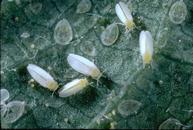Unused stories
Pest of the Month - Whiteflies
See some fluttering around your geraniums?

Signs of a whitefly infestation can include:
- Tiny nymphs on the underside of leaves.
- Sticky honeydew on leaves, on fruit, or beneath plants, or a covering of black sooty mold.
- Yellowing, silvering, or drying leaves that have whitefly nymphs on them.
- Deposits of white wax with some whiteflies.
Protect natural enemies such as lacewings, lady beetles, and mini-wasps:
- Avoid using pesticides such as pyrethroids, organophosphates, carbaryl, or foliar sprays of imidacloprid.
- Prevent dusty conditions.
- Keep ants, which protect whiteflies from natural enemies, out of plants
- Recognize signs of parasitization such as circular holes in nymphs (see back) or a change in color.
Install a reflective mulch in your vegetable garden to protect young plants:
- Use aluminum-coated construction paper or reflective plastic mulch products.
- Lay the product on bare soil, bury its edges with soil, and insert seedlings or seeds into holes that you make in the mulch.
- Plastic mulches require drip irrigation underneath them; paper mulches can be sprinkle or furrow irrigated.
- Mulches repel whiteflies and other small flying insects such as aphids while plants are small. Remove mulches when plants get large and temperatures get hot.
Use hand removal and traps to reduce whiteflies:
- Prune out isolated infested leaves when you first detect them.
- Hose off adults or use a hand-held vacuum.
- Install ready-to-use, sticky-coated yellow traps or make your own. Use one trap for every medium-size vegetable plant.
- Promptly destroy infested annuals when flowering or fruiting ends.
Pesticides
Even the most toxic insecticides are only partially effective. If you decide to treat, choose products that are least harmful to natural enemies — such as insecticidal soaps and oils including neem oil—and combine their use with the other practices listed above. Good coverage, including the underside of leaves, is essential. Repeat applications might be required. Avoid using even these pesticides if many natural enemies are present.
From Pests in Gardens and Landscapes: Quick Tips, UC IPM website
